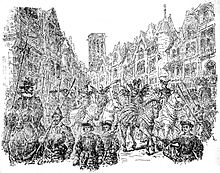Siege of La Rochelle (1573)
Montauban - Montpellier - La Rochelle (1573) - Blockade of La Rochelle - La Rochelle (1627–1628) - Royan - Saint-Antonin - Saint-Jean-d'Angély
The siege of La Rochelle , ordered by King Charles IX. and commanded by the Duke of Anjou , later King Henry III. , began on February 11, 1573 and ended on June 26 of the same year.
The night of St. Bartholomew had dealt a heavy blow to the Protestants . The king and his mother Catherine de Medici wanted to use the chaos now prevailing on the other side to finally force them under their authority. Their destination was La Rochelle , the city at the forefront of French Protestantism, the fall of which would have a domino effect on the other Protestant cities. The king hoped to negotiate, but the Protestants refused to submit, so the siege was decided.
In addition to his brother François-Hercule , the Duke of Anjou was accompanied by Henry of Navarre , later King Henry IV, and Henri I de Bourbon, prince de Condé , both of whom had just converted to Catholicism . Anjou commanded an army of 5000 infantrymen and 1000 cavalrymen , including the entire Catholic nobility of the country: the Grand Master of the Artillery Armand de Gontaut-Biron , the heads of the Catholic Party, Luigi Gonzaga , Henri I de Lorraine, duc de Guise , Charles II . de Lorraine, duc de Mayenne , Claude de Lorraine, duc d'Aumale , Blaise de Montesquiou, seigneur de Montluc , but also Artus de Cossé-Brissac , Marshal of France , Henri de la Tour d'Auvergne , Villequier, Pierre de Bourdeille , seigneur de Brantôme , Albert de Gondi, duc de Retz Filippo Strozzi and although a Protestant Henri-Robert de La Marck .
La Rochelle, on the other hand, was without an actual military commander. François de La Noue worked on behalf of both the Protestants and the king. The city was in the hands of the citizens who had about 1,300 soldiers under arms. English ships supplied them with supplies, while Queen Elizabeth I was allied with France and officially condemned the English aid deliveries for La Rochelle, but actually supported them. The English could call into the roadstead unhindered , unload and sail away again. The attempts to fill in the gap failed. On April 19, however, it was possible to force an English fleet under the command of Montgomery to turn back by a hail of cannons.
On land, eight large assaults on the walls were launched from February to June, suicide missions, as hardly anyone returned unharmed from these attacks. The Duke of Anjou was among the wounded several times, Claude de Lorraine fell on March 3rd. On March 26th, 150 besiegers died in a premature explosion of a projectile that was to be thrown over the walls. The resistance of the Protestants, the failure of the assaults and difficulties with the provisions made the besiegers desperate. Intrigues arose in the royal camp, with François-Hercule at the head. On May 23, 6,000 Swiss reinforcements arrived, but the general attack three days later also failed. On May 28th, Heinrich III. of his election as King of Poland , a country in which there was freedom of conscience and religion (cf. Confederation of Warsaw ).
The siege was abandoned on June 26th and a peace treaty was signed on July 6th.
literature
- Jean-Louis Bourgeon: "De Mons à la Rochelle via Paris, ou les paradoxes de Monsieur de La Noue (1572-1573)", in: Bulletin de la société de l'histoire du protestantisme français , 1992, vol. 138, n ° 1, pp. 5-18.
- Pascal Rambeaud: La Rochelle, fidèle et rebelle , Paris, Éditions Le Croît Vif, collection “Documentaire”, 1999.


